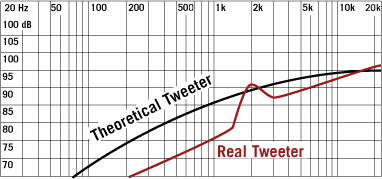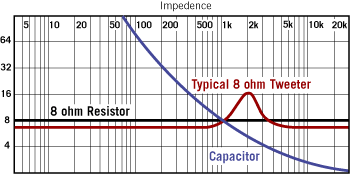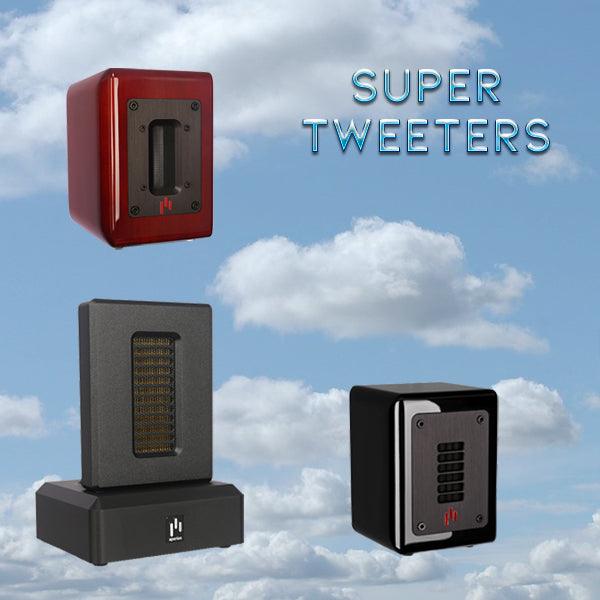 Have you ever wondered what goes on inside a speaker? If you’ve ever taken a speaker apart, then you know there is usually a small circuit board with a few components that is attached to each driver. What is the purpose of that circuit board? This is what is known as the speaker’s crossover and it plays the critical role of ensuring that each different driver in a speaker plays the range of frequencies for which it was designed. Crossover technology applies both in Passive and Active speakers. This article will take a look at exactly why speakers rely on crossovers to function optimally and how the crossover works.
Have you ever wondered what goes on inside a speaker? If you’ve ever taken a speaker apart, then you know there is usually a small circuit board with a few components that is attached to each driver. What is the purpose of that circuit board? This is what is known as the speaker’s crossover and it plays the critical role of ensuring that each different driver in a speaker plays the range of frequencies for which it was designed. Crossover technology applies both in Passive and Active speakers. This article will take a look at exactly why speakers rely on crossovers to function optimally and how the crossover works.
What does a speaker crossover do?
Speakers really are pretty amazing, they can produce the full range of sound that we can hear just with as little two drivers or in some cases one single full range driver. The highest frequency humans can hear requires a speaker’s driver to move back and forth 20,000 time a second in order to make 2/3” long sound waves. The deepest audible bass makes the driver move about 20 times a second and sends 50’ long wavelengths through your room. That may sound like hard work, but speaker drivers do it every moment they’re playing music. The physics that govern what it takes to produce these waves demands different kinds of mechanisms for producing the fast, short waves than for the long, slow ones. Which is why speakers contain tweeters to play the high frequencies, woofers to play bass wavelengths and sometimes use midrange drivers to cover in between frequencies as well as deep bass specialists, subwoofers. So the first job of a crossover is to ensure that the proper frequencies are sent to each driver.

But wait, there’s more! The crosssover is truly where the “magic” of a speaker happens as it determines what each individual driver plays. It does this because speaker drivers need help. Lots of help. They play louder (are more “sensitive”) at some frequencies than others and can benefit from being “equalized”. Tweeters are usually more sensitive, that is they play louder when fed a given amount of power, than woofers and need to be brought into balance. The cabinet also effects the sensitivity of a speaker through its resonant frequency and thus needs to be addressed by the design of the crossover as well. So, the second job of the crossover is to modulate the signal to each driver in the following manner:
- Makes sure each driver receives the range of frequencies for which it is optimized
- Allows for adjacent drivers to integrate together seamlessly in terms of frequency
- Matches different driver outputs so they all play together at the same loudness
And, believe it or not, that’s not all. Crossovers affect the timing of when sound waves originate from a driver which, in turn, determines if the waves from other drivers meet in a coordinated fashion or not. This is known as keeping the outputs from each driver “in phase” and ensures that the waves from each driver do not cancel each other or create partial interference. Lastly, crossovers play a large role in defining the only speaker property your receiver cares about; its impedance.
So that’s a brief description of what crossovers do. From here on out, the discussion will get a little more technical. If you’re not already versed in some audio vocabulary and concepts, we recommend that you first read “The Science of Sound” before proceeding. If you’re fairly well learned in this subject, then let’s have some fun and get down to the nitty gritty!
How does a crossover do that?
Crossovers use circuits with components to create the specific range of frequencies and output that are tailored for each driver. You might be surprised to learn that most crossover networks only use the following three components:
- Resistors – These components are used to reduce the output of a driver
- Capacitors – Components which act as high pass filters and block low frequencies while passing high frequencies
- Coils or Inductors – These are low pass filters and block high frequencies while passing low frequencies
Resistors: Say an amplifier is delivering 10 watts of power to an 8 ohm tweeter. Then you place an 8 ohm resistor in line with it (in series), how much power will reach the tweeter? The answer is 2.5 watts. The new 8 ohm + 8 ohm load tells the amplifier to deliver only half the power as before (5 watts) and half of that power is “used” by the resistor; half by the tweeter. This would attenuate, or lessen, the entire tweeter’s range by 6 dB if, in fact, the tweeter was 8 ohms at all frequencies. So this is how resistors can reduce the output of a particular driver.

Capacitors: A capacitor placed in series with a speaker, as shown in the schematic below, will act as a high pass filter and block the low frequencies and pass the highs on through. Notice that the “roll-off” slope is fairly gradual and smooth – this is the theoretical slope that occurs when the tweeter has a flat frequency and impedance response (they remain constant with frequency). The steepness of the slope eventually reaches the point where it attenuates 6dB for every octave further away from the tweeter’s operating range. This is often called a 6dB/octave or 1st order rolloff slope.

Maybe the crossover designer wants a steeper slope so that the tweeter won’t receive so much energy below where it operates well. They may try something like this, which results in a 12db/oct or 2nd order rolloff slope.

Steeper slopes – 3rd order (18dB/oct) & 4th order (24dB/oct) are sometimes used – can be obtained with more parts. Changing the part values will result in differently shaped slopes – maybe you’ve heard of Linkwitz-Riley, Bessel, Butterworth (not the syrup) or other kinds.
Next, let’s see what happens when we throw a woofer into the design:
Inductors: The key thing to notice here is that we have introduced an inductor in series with the woofer by placing it in line with its positive terminal. Inductors behave the opposite way of capacitors and are what is known as a low pass filter, which removes high frequencies from the signal and allows low frequencies to move through the circuit.

Notice how the total speaker output in the crossover zone, the dashed red line, depends on the sum of the woofer’s and tweeter’s outputs?
What happens in the real world is complicated
So you’re thinking, “That’s pretty easy – Just figure out what frequency and slope type I want, then pick the part values off of a chart.” If that were true, crossovers could be designed in a few hours instead of a few weeks or months! Unfortunately, once real drivers and enclosures come into play, the above crossover might produce a graph something like the one below. Real world situations introduce some complications we’ll look at below:

 Drivers don’t have perfectly flat frequency responses and will have peaks and valleys at different frequencies. If these deviations occur near the crossover frequency, adjusting the parts values in the crossover can sometimes adequately address them. Other times, a notch filter that removes a specific frequency range can flatten-out a peak.
Drivers don’t have perfectly flat frequency responses and will have peaks and valleys at different frequencies. If these deviations occur near the crossover frequency, adjusting the parts values in the crossover can sometimes adequately address them. Other times, a notch filter that removes a specific frequency range can flatten-out a peak.
Tweeters are almost always more efficient than woofers and need to be brought down to a suitable level by using resistors as we mentioned before.
Waves can do some funny things. For example, waves shorter than the surface from which they originate tend to beam their energy forward, similar to light from a flashlight. Waves significantly longer than the front surface of a speaker, wrap around the enclosure and disperse pretty much evenly in all directions. The result is a lower energy density in front of the speaker for the evenly dispersing bass than for the forward directed higher frequencies (shorter wave lengths). This 6dB bass loss, sometimes called a “diffraction step,” means that the rest of the speaker’s output will need to be brought down to the now lowered bass level (unless the speaker near the wall behind it where waves are prevented from wrapping around). Often speaker designers will accomplish most of this by increasing the value of the first coil in series with the woofer, which is why it can be 2 to 4 times larger in value than what a chart prescribes.
 Here’s another interesting thing waves do. When two waves of the same frequency meet, they band together as long as they’re “in phase” and will reinforce each other. Alternatively, if two waves of the same frequency are 180° out of phase with one another, they will completely cancel each other out. In other cases when the waves are phase shifted by values between 0° and 180°, they will partially cancel each other out. With speakers, this happens in the crossover zone where two drivers share the same frequencies. In the graph to the left, the drivers are 180° out of phase with each other and you can see that the combined output is zero where the transition occurs between the two drivers. Simply wiring the tweeter “backward” (with amp positive to tweeter negative) can correct this problem. But, if the phase differences tuned out to be, say, 90°, then there would always be some cancellation and the driver outputs would need to be increased in the crossover zone to compensate.
Here’s another interesting thing waves do. When two waves of the same frequency meet, they band together as long as they’re “in phase” and will reinforce each other. Alternatively, if two waves of the same frequency are 180° out of phase with one another, they will completely cancel each other out. In other cases when the waves are phase shifted by values between 0° and 180°, they will partially cancel each other out. With speakers, this happens in the crossover zone where two drivers share the same frequencies. In the graph to the left, the drivers are 180° out of phase with each other and you can see that the combined output is zero where the transition occurs between the two drivers. Simply wiring the tweeter “backward” (with amp positive to tweeter negative) can correct this problem. But, if the phase differences tuned out to be, say, 90°, then there would always be some cancellation and the driver outputs would need to be increased in the crossover zone to compensate.
So you can see that controlling the rolloff slopes, both output and phase, is important for getting the drivers to sum properly. But the slope that matters isn’t what comes out of the crossover – it’s what comes out of the drivers. This means that driver’s natural roll-offs characteristics, the crossover’s rolloff (and more) all work together to produce the phase and amplitude that determine how well the sound from the two drivers will integrate through the crossover zone.
 When two drivers share the same frequencies, the amount that their waves add to each other also depends on where the listener is. The illustration above shows a speaker with a tweeter positioned above a woofer, a green listener, who is standing and a blue listener who is sitting down. The waves the listener who is standing up is hearing are arriving at the same time and reinforcing each other, resulting in a higher level in dB than each individual driver’s output. While the waves that reach the ear of the seated listening are out of phase and canceling each other which causes a drastically reduced signal in dB. By the way, this is why drivers are usually above one another, so that this problem will manifest itself vertically – hopefully above and below the listening area.
When two drivers share the same frequencies, the amount that their waves add to each other also depends on where the listener is. The illustration above shows a speaker with a tweeter positioned above a woofer, a green listener, who is standing and a blue listener who is sitting down. The waves the listener who is standing up is hearing are arriving at the same time and reinforcing each other, resulting in a higher level in dB than each individual driver’s output. While the waves that reach the ear of the seated listening are out of phase and canceling each other which causes a drastically reduced signal in dB. By the way, this is why drivers are usually above one another, so that this problem will manifest itself vertically – hopefully above and below the listening area.
 While it’s tempting to think of crossovers as filters that divide the frequencies up and send them on their way, they don’t really work that way. The amount that a crossover attenuates a driver depends on how much impedance it presents compared to the driver. Unfortunately, drivers usually have impedances that fluctuate greatly over their operating range. The graph below shows the impedances of a high-pass filter (capacitor) in blue, an ideal tweeter (resistive) in black and a real tweeter in red. The graph to the right shows the energy the idealized tweeter receives (again black) compared to what our real tweeter receives (red).
While it’s tempting to think of crossovers as filters that divide the frequencies up and send them on their way, they don’t really work that way. The amount that a crossover attenuates a driver depends on how much impedance it presents compared to the driver. Unfortunately, drivers usually have impedances that fluctuate greatly over their operating range. The graph below shows the impedances of a high-pass filter (capacitor) in blue, an ideal tweeter (resistive) in black and a real tweeter in red. The graph to the right shows the energy the idealized tweeter receives (again black) compared to what our real tweeter receives (red).
 The last real-world complication worth listing here is that crossover parts have many electrical properties in addition to what they’re designed to have. This makes for effects that are different than what a textbook would predict.
The last real-world complication worth listing here is that crossover parts have many electrical properties in addition to what they’re designed to have. This makes for effects that are different than what a textbook would predict.
In Conclusion
A while ago you may have been thinking that crossover design sounded pretty easy – but now you’re convinced that it must be close to impossible. The truth is that it’s really not that bad if you know the secret that many speaker designers keep to themselves – that it’s speaker performance that matters, not theory. Designers don’t need to calculate adjacent slopes, how the sound from two sources will add together and so on. They can just fiddle with everything until they deliver the desired sound — though it’s very true that knowing the theory makes you a much better fiddler. And now there are highly precise computer modeling programs that can get a designer pretty close. But the process really comes down to a lot of trial and error, measuring frequency and impedance character, listening and repeating over and over again until the speaker performance gets the big thumbs-up both in terms of measurement and listening tests. Which is why good measuring equipment, a panel of golden ears and a good listening room are as indispensable when designing crossovers and the speakers that use them.
We hope you enjoyed this deep dive into the principles of crossover and speaker design and that it gave you a little more understanding of what we do here at Aperion Audio. If not, just sit back and enjoy the fruits of our labor and as always, happy listening!


 https://www.aperionaudio.com
https://www.aperionaudio.com